40 lives lost to the cruel sea. 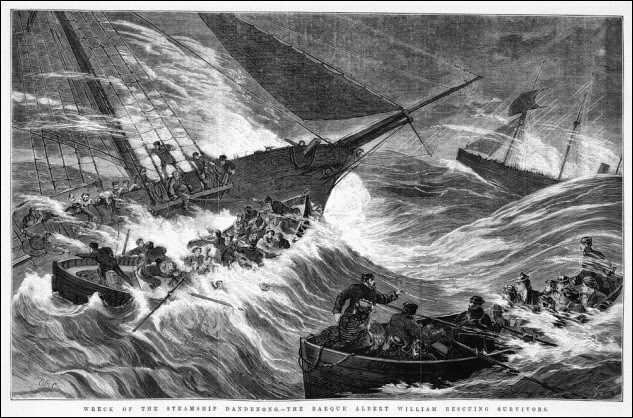
Amongst the many sea stories that have come across my desk from the 1800’s the story of the sinking, heroics, self sacrifice and loss of life on the SS Dandenong is truly a sad tale and one of the worst sea tragedies of its time in these waters.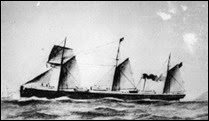 Specifications: The Dandenong iron screwed steamer, 743 tons, built 1867, length 291 ft, beam 28ft 2in, constructed with three water tight compartments.
Specifications: The Dandenong iron screwed steamer, 743 tons, built 1867, length 291 ft, beam 28ft 2in, constructed with three water tight compartments.
Described as being of sturdy build, with all equipment of the highest standard.
A well known and respected regular on the Melbourne to Sydney run.
Friday afternoon September 8th 1876.
In good weather the passenger steamer SS Dandenong left Melbourne on the 8th of September under the command of Captain Irwin carrying 53 passengers.
Like so many other earlier ships before her, she had no idea what lay ahead, near Wilsons Promontory she started to run into foul weather, as she travelled further up the coast the winds became gale force, the sea rose and became very violent.
1.30am Monday morning the 10th.
Nearing Jervis Bay passengers sleeping in the officers quarter in the aft part of the ship were awakened by a sudden shock beneath them, inspection revealed she had broken her propeller shaft, tearing a hole in her and she immediately began taking water.
The crew worked hard to stem the flow by using blankets, bedding and anything else they thought might help stop the leak. But the attempts were futile as the aperture around the shaft was very large, and she began to settle by the stern, water extinguished the boiler fires and the pumps failed.
In an attempt to lighten the ship her cargo of malt, rice, tea, kerosene, iron and furniture were jettisoned, but this had no effect on the water rushing in.
All hope of saving the ship are gone, lifeboats are readied.
Captain Irwin ordered the lifeboats to be readied and get prepared to leave the ship.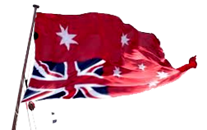
Ensign Union Down
Monday 11th 2.30pm – The Barque, Albert William arrives on the scene.
The Dandenong crew observed sails on the weatherbow, which proved to be the Barque Albert William, the crew of the Dandenong immediately hoisted the Ensign, union down, the Albert William observed the Dandenong’s distress signal and “hove to” all the while the crew and passengers were manually pumping and using buckets to try and decrease the rising water below.
Communication between the vessels was ongoing and plans were implemented to get the lifeboats away. The first lifeboat was launched from the Dandenong with the chief officer and four men taking charge and about 18 passengers managing to get into the life raft, mostly women and children.
‘‘The sea was terrific but five adults and eight children succeeded in getting into the lifeboat,’’ the chief officer said.
‘‘But on getting alongside the Albert William, the barque rolled so heavily she struck her and split her in two, precipitating all aboard into the water.’’
One child, two men and the chief officer were saved, the rest drowned.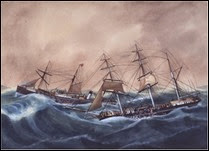 A second boat successfully carried many to safety, however a collision between this and a third boat cost more lives, and when darkness fell more than 30 still remained aboard the doomed vessel.
A second boat successfully carried many to safety, however a collision between this and a third boat cost more lives, and when darkness fell more than 30 still remained aboard the doomed vessel.
The Albert William, having rescued 28 passengers and 12 crew, stayed alongside the sinking steamer throughout the night.
The S.S. Dandenong foundering off Jervis Bay, 1876 - Gregory, George Frederick
8.30pm Monday Lights of the Dandenong disappear.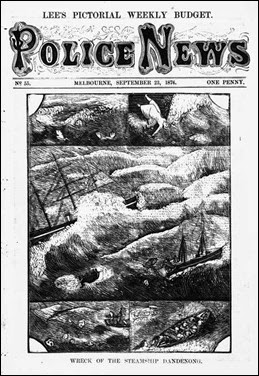 In the minds of nautical men, there remains but little doubt that when the look out on board the Albert William lost sight of her lights between 8-9 o’clock, she foundered, and all of those on board not one being left to tell the sad tale of what took place from the time darkness set in.
In the minds of nautical men, there remains but little doubt that when the look out on board the Albert William lost sight of her lights between 8-9 o’clock, she foundered, and all of those on board not one being left to tell the sad tale of what took place from the time darkness set in.
Described as “labouring like a log in the sea” with her bows smashed in there was little hope of finding her afloat and “taking all matters into consideration, there can be but little doubt when plunging down one of the heavy seas she went to the bottom stern first”
9am Tuesday.
After searching from first light no trace of the Dandenong could be found, the yards were squared, and the Barque kept away on her course for Newcastle.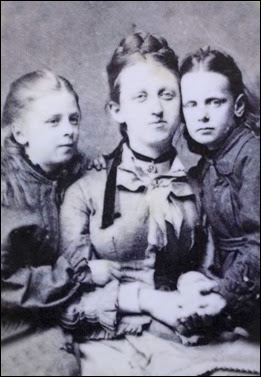 At daybreak no sign could be seen of the Dandenong. The scene at the time of the rescue was described as ‘‘heartrending’’. A little girl who had been saved lost her mother, father, three brothers and two sisters. One boy saved lost his mother.
At daybreak no sign could be seen of the Dandenong. The scene at the time of the rescue was described as ‘‘heartrending’’. A little girl who had been saved lost her mother, father, three brothers and two sisters. One boy saved lost his mother.
As soon as news of the tragedy became known, several boats were dispatched to assist, including one belonging to the Bulli Coal Company. Telegrams were also sent to Wollongong and Kiama, asking if vessels could join the search and rescue.
Two orphans and the stewardess rescued from the Dandenong
Collection from the Wollongong City Library and the Illawarra Historical Society.
Forlorn hope.
”The telegraph office and the office of the owner Captain W.Howard Smith in Market street, were frequently visited throughout the day by the relatives of those still left on board the steamer on Monday night when darkness set in.
They were in continual hopes that a telegram might be received announcing the return of one of the searching ships with the Dandenong in tow”.
Shock and disbelief.
At first news of the sinking was met with skepticism, but when the telegrams confirmed the reports the news of the sinking and the fate of the passengers was met with great shock and melancholy.
The enquiry’s final verdict, They acted with great bravery.
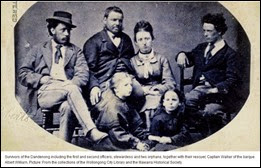 A Court of Inquiry found that the captain, officers and crew did all in their power to save the ship.
A Court of Inquiry found that the captain, officers and crew did all in their power to save the ship.
The wreck of the Dandenong has never been found.
Link to a folk song about the Wreck of the Dandenong - http://ozfolksongaday.blogspot.com.au/2011/10/wreck-of-dandenong.html
REF:
http://trove.nla.gov.au/ndp/del/article/5903090
http://trove.nla.gov.au/ndp/del/article/28400062
http://www.ozhistorymine.com/html/dandenong_1876.html
http://news.google.com/newspapers?nid=1301&dat=18760930&id=xkMQAAAAIBAJ&sjid=HpEDAAAAIBAJ&pg=5436,2148063
Painting details
http://catalogue.statelibrary.tas.gov.au/item/?id=170816
Title: [The S.S. Dandenong foundering off Jervis Bay, 1876] / G.F.G
Creator: Gregory, George Frederick, c. 1824-1887
Description: 1 painting : watercolour ; 38 x 50 cm
Meaning of
Hove to
1.In sailing, heaving to (to heave to and to be hove to) is a way of slowing a sail boat's forward progress.
2.To turn a sailing ship so that its bow heads into the wind and the ship lies motionless except for drifting.
Weatherbow: The side of the bow toward the wind.
Foundered: To fill with water and sink.
A Barque like the Albert William - has a minimum of three masts two of which are square-rigged, except the aft (mizzen) which is fore and aft rigged

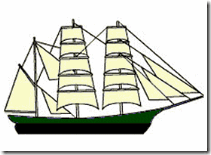
No comments :
Post a Comment